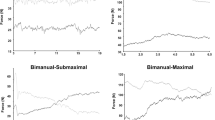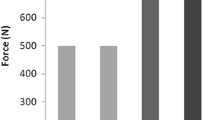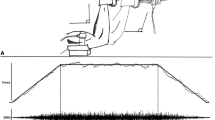Abstract
Purpose
The bilateral deficit (BLD) is characterized by a reduction in maximal voluntary torque during a bilateral contraction relative to the sum of left and right unilateral contractions. The BLD has been attributed to interhemispheric inhibition as a result of unilateral torque differences between limbs. If the BLD is the result of interhemispheric inhibition, lowering activation for a torque matching task, as shown in residual force enhancement (RFE), may help overcome the decrease in neural drive during bilateral contractions. Therefore, the purpose of the present study was to determine whether RFE could reduce the BLD.
Methods
Participants (n = 12) performed both isometric and RFE MVCs of the elbow flexors under three conditions: (1) unilateral-left; (2) unilateral-right; and (3) bilateral. To directly address the purpose of the study, a sub-group of participants that displayed both RFE and a BLD (“Responders”, n = 6) were selected from the participant pool.
Results
“Responders” displayed RFE (7.1 ± 5.3%) and an isometric BLD (BI: − 9.9 ± 3.2%). In the RFE state, the BLD was no longer significant (− 5.8 ± 7.9%), accompanied by the elimination of differences in biceps brachii EMG between arms (left: − 11.7 ± 10.3%; right: − 11.5 ± 13.2%), as seen during isometric contractions (left: − 12.0 ± 23.2%; right: − 21.1 ± 16.6%).
Conclusion
Residual force enhancement appears to mitigate the BLD, alleviating the effects of a decrease in neural drive by allowing more force for a given level of muscle activation when compared to a purely isometric contraction.





Similar content being viewed by others
Abbreviations
- RMS:
-
Root mean square
- BLD:
-
Bilateral deficit
- EMG:
-
Electromyography
- MVC:
-
Maximal voluntary contraction
- RFE:
-
Residual force enhancement
References
Altenburg TM, de Ruiter CJ, Verdijk PW, van Mechelen W, de Haan A (2008) Vastus lateralis surface and single motor unit EMG following submaximal shortening and lengthening contractions. Appl Physiol Nutr Metab (Physiologie appliquee nutrition et metabolisme) 33:1086–1095. https://doi.org/10.1139/H08-092
Belanger AY, McComas AJ (1981) Extent of motor unit activation during effort. J Appl Physiol Respir Environ Exerc Physiol 51:1131–1135
Bullimore SR, Leonard TR, Rassier DE, Herzog W (2007) History-dependence of isometric muscle force: effect of prior stretch or shortening amplitude. J Biomech 40:1518–1524. https://doi.org/10.1016/j.jbiomech.2006.06.014
Cornwell A, Khodiguian N, Yoo EJ (2012) Relevance of hand dominance to the bilateral deficit phenomenon. Eur J Appl Physiol 112:4163–4172. https://doi.org/10.1007/s00421-012-2403-z
Ferbert A, Priori A, Rothwell JC, Day BL, Colebatch JG, Marsden CD (1992) Interhemispheric inhibition of the human motor cortex. J Physiol 453:525–546
Fortuna R, Power GA, Mende E, Seiberl W, Herzog W (2016) Residual force enhancement following shortening is speed-dependent. Sci Rep 5:21513. https://doi.org/10.1038/srep21513
Gandevia SC (2001) Spinal and supraspinal factors in human muscle fatigue. Physiol Rev 81:1725–1789
Hahn D, Seiberl W, Schwirtz A (2007) Force enhancement during and following muscle stretch of maximal voluntarily activated human quadriceps femoris. Eur J Appl Physiol 100:701–709. https://doi.org/10.1007/s00421-007-0462-3
Henry FM, Smith LE (1961) Simultaneous vs separate bilateral muscular contractions in relation to neural overflow theory and neuromoter specificity. Res Q 32:42–46
Herzog W, Schappacher G, DuVall M, Leonard TR, Herzog JA (2016) Residual force enhancement following eccentric contractions: a new mechanism involving titin. Physiology (Bethesda) 31:300–312. https://doi.org/10.1152/physiol.00049.2014
Howard JD, Enoka RM (1991) Maximum bilateral contractions are modified by neurally mediated interlimb effects. J Appl Physiol 70:306–316
Jakobi JM, Chilibeck PD (2001) Bilateral and unilateral contractions: possible differences in maximal voluntary force Can. J Appl Physiol 26:12–33
Jones AA, Power GA, Herzog W (2016) History dependence of the electromyogram: implications for isometric steady-state EMG parameters following a lengthening or shortening contraction. J Electromyogr Kinesiol 27:30–38. https://doi.org/10.1016/j.jelekin.2016.01.008
Leonard TR, DuVall M, Herzog W (2010) Force enhancement following stretch in a single sarcomere. Am J Physiol Cell Physiol 299:C1398–C1401. https://doi.org/10.1152/ajpcell.00222.2010
Matkowski B, Martin A, Lepers R (2011) Comparison of maximal unilateral versus bilateral voluntary contraction force. Eur J Appl Physiol 111:1571–1578. https://doi.org/10.1007/s00421-010-1775-1
Mehta A, Herzog W (2008) Cross-bridge induced force enhancement? J Biomech 41:1611–1615. https://doi.org/10.1016/j.jbiomech.2008.02.010
Oda S, Moritani T (1994) Maximal isometric force and neural activity during bilateral and unilateral elbow flexion in humans. Eur J Appl Physiol Occup Physiol 69:240–243
Oda S, Moritani T (1995) Movement-related cortical potentials during handgrip contractions with special reference to force and electromyogram bilateral deficit. Eur J Appl Physiol Occup Physiol 72:1–5
Oda S, Moritani T (1996) Cross-correlation studies of movement-related cortical potentials during unilateral and bilateral muscle contractions in humans. Eur J Appl Physiol Occup Physiol 74:29–35
Ohtsuki T (1983) Decrease in human voluntary isometric arm strength induced by simultaneous bilateral exertion. Behav Brain Res 7:165–178
Oskouei AE, Herzog W (2005) Observations on force enhancement in submaximal voluntary contractions of human adductor pollicis muscle. J Appl Physiol 98:2087–2095. https://doi.org/10.1152/japplphysiol.01217.2004
Perez MA, Butler JE, Taylor JL (2014) Modulation of transcallosal inhibition by bilateral activation of agonist and antagonist proximal arm muscles. J Neurophysiol 111:405–414. https://doi.org/10.1152/jn.00322.2013
Power GA, Rice CL, Vandervoort AA (2012) Residual force enhancement following eccentric induced muscle damage. J Biomech 45:1835–1841. https://doi.org/10.1016/j.jbiomech.2012.04.006
Power GA, Makrakos DP, Stevens DE, Herzog W, Rice CL, Vandervoort AA (2014) Shortening-induced torque depression in old men: implications for age-related power loss. Exp Gerontol 57:75–80. https://doi.org/10.1016/j.exger.2014.05.004
Seiberl W, Hahn D, Herzog W, Schwirtz A (2012) Feedback controlled force enhancement and activation reduction of voluntarily activated quadriceps femoris during sub-maximal muscle action. J Electromyogr Kinesiol 22:117–123. https://doi.org/10.1016/j.jelekin.2011.10.010
Seiberl W, Power GA, Hahn D (2015) Residual force enhancement in humans: current evidence and unresolved issues. J Electromyogr Kinesiol 25:571–580. https://doi.org/10.1016/j.jelekin.2015.04.011
Skarabot J, Cronin N, Strojnik V, Avela J (2016) Bilateral deficit in maximal force production. Eur J Appl Physiol. https://doi.org/10.1007/s00421-016-3458-z
Weir JP, Housh DJ, Housh TJ, Weir LL (1995) The effect of unilateral eccentric weight training and detraining on joint angle specificity, cross-training, and the bilateral deficit. J Orthop Sports Phys Ther 22:207–215. https://doi.org/10.2519/jospt.1995.22.5.207
Acknowledgements
We would like to thank all of the participants in this study. This project was supported by the Natural Sciences and Engineering Research Council of Canada (NSERC), Ontario Graduate Scholarship Program, Alberta Innovates Health Solutions (AIHS), and Eyes High Doctoral Recruitment Scholarship. Infrastructure was provided by the University of Guelph start-up funding.
Author information
Authors and Affiliations
Contributions
GZM was responsible for the design of the study, execution of the study, data collection, data analysis, interpretation of data, drafting the manuscript, revising the manuscript, and approving the final submitted version. NM was responsible for data analysis, interpretation of data, drafting the manuscript, revising the manuscript, and approving the final submitted version. WH was interpretation of data, drafting the manuscript, revising the manuscript, and approving the final submitted version. GAP was responsible for the design of the study, execution of the study, data collection, data analysis, interpretation of data, drafting the manuscript, revising the manuscript, and approving the final submitted version.
Corresponding author
Ethics declarations
Ethical approval
All participants gave written informed consent and all procedures were approved by the local Research Ethics Board and conformed to the Declaration of Helsinki.
Conflict of interest
The authors declare that they have no conflict of interest.
Additional information
Communicated by Toshio Moritani.
Rights and permissions
About this article
Cite this article
MacDonald, G.Z., Mazara, N., Herzog, W. et al. Mitigating the bilateral deficit: reducing neural deficits through residual force enhancement and activation reduction. Eur J Appl Physiol 118, 1911–1919 (2018). https://doi.org/10.1007/s00421-018-3924-x
Received:
Accepted:
Published:
Issue Date:
DOI: https://doi.org/10.1007/s00421-018-3924-x




